Skeletons in the Stacks: Cheselden’s Spine-Tingling Osteological Atlas
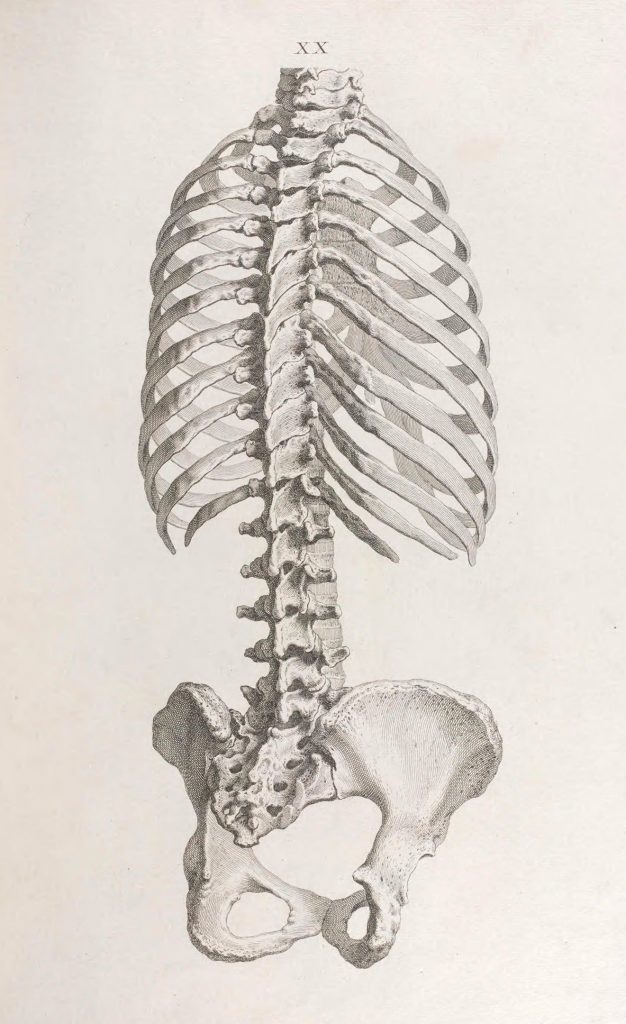
Plate XX. Cheselden, William. Osteographia. 1733. Contributed in BHL from the Library and Archives of the Natural History Museum, London.
Halloween is just around the corner, and the skeletons have come out of the closet. From front yards reimagined as graveyards to bone-chilling retail displays and party backdrops rattling with more than a few spare ribs, bones are on display to awaken the Halloween spirit and set a ghoulish mood to the delight of trick-or-treaters everywhere.
The modern-day Halloween is derived from the ancient Celtic festival of Samhain. With the Celtic new year celebrated on November 1, October 31 marked the end of summer and the harvest and the beginning of the cold, dark winter. Samhain, celebrated the evening of October 31, was believed to be a time when the boundary between the worlds of life and death were blurred, allowing the ghosts of the dead to return (History.com 2019).
Over time, Halloween has evolved into the costume-wearing, trick-or-treating holiday that it is today, but the season’s association with death has remained, evidenced by the proliferation of ghosts and skeletons intertwined with modern-day celebrations.
Embracing the Halloween season’s bony obsession, this month’s book of the month is one devoted to the skeleton — Osteographia (1733), which has been described as “one of the most important and beautiful books in the British anatomical tradition” (Neher 2010, 517). This work is freely available in BHL thanks to the Library and Archives of the Natural History Museum in London.
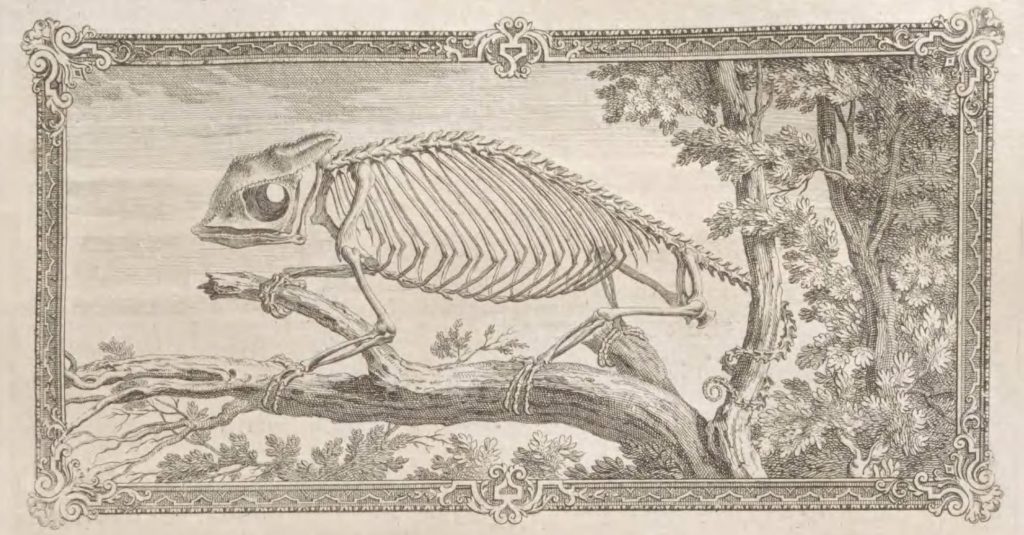
Head-piece engraving for Chapter VI. Cheselden, William. Osteographia. 1733. Contributed in BHL from the Library and Archives of the Natural History Museum, London.
William Cheselden created his Osteographia with two goals in mind: to offer both the best osteological atlas and the most accurate study of the human skeleton yet produced. The book’s 56 massive plates, measuring 21 inches long and 15 inches wide, offer natural-size depictions of the separate human bones. Complete copies include two sets of plates — one set lettered with text on the verso providing descriptions of the figures, and one unlettered and blank on the verso “to shew them in their full Perfection”. Each chapter is also adorned with head and tail-piece engravings depicting various animal skeletons (Russell 1954, 38).
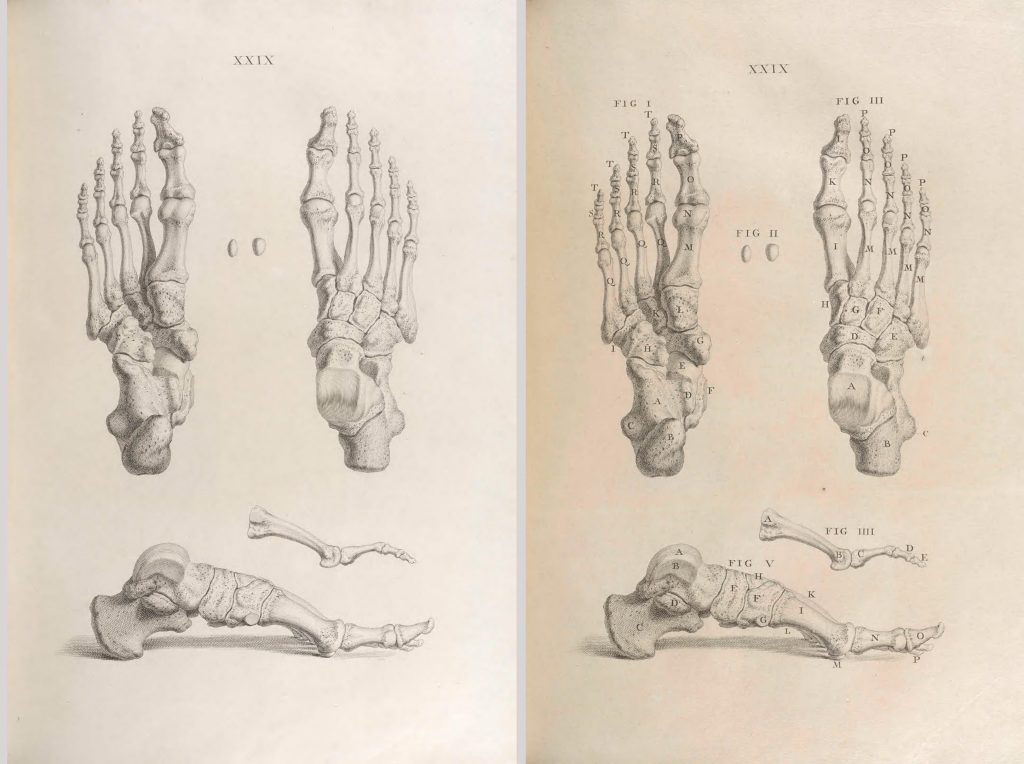
Plate XXIX, comparison of unlettered (left) and lettered (right) plates. Complete copies include full sets of both lettered and unlettered plates. Cheselden, William. Osteographia. 1733. Contributed in BHL from the Library and Archives of the Natural History Museum, London.
Cheselden spent years engaged in the production of Osteographia. A British surgeon and teacher of anatomy and surgery, Cheselden (1688-1752) is well-known for his Anatomy of the Human Body (1713), which was used as an anatomy textbook for nearly a century. Well-respected during his time, Cheselden was one of the principal surgeons at St. Thomas’ Hospital and was appointed the surgeon to Queen Caroline in 1727 (Tikkanen 2019).
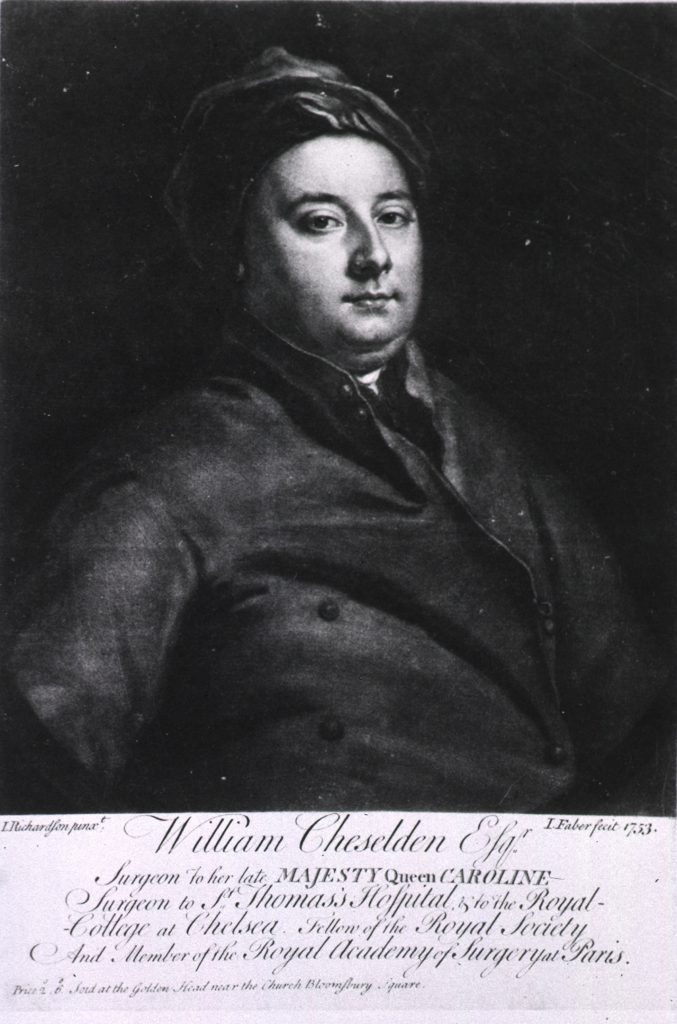
Portrait of William Cheselden. Engraving by J. Faber after J. Richardson. 1753. Source: U.S. National Library of Medicine.
Cheselden was also a clever marketer who used the popularity of his anatomical textbook to advertise his forthcoming osteological atlas. Within the Preface to the 1726 edition of his Anatomy, Cheselden wrote that he was “much engaged” in the production of an Osteology that would provide life-size plates of the human bones. He went so far as to include an example of some of the engravings from his atlas (specifically, the maxilla and mandible figured on Plate IX of Osteographia).
Published in 1733, Cheselden limited the English edition of Osteographia to 300 copies, plus an additional 100 prints of the plates intended for a foreign edition in either Latin or French (which was never produced) (Russell 1954, 44). Following these printings, the plates were destroyed so that “the price of the book may never sink in the possession of the subscribers” (Cheselden 1733, [3]).
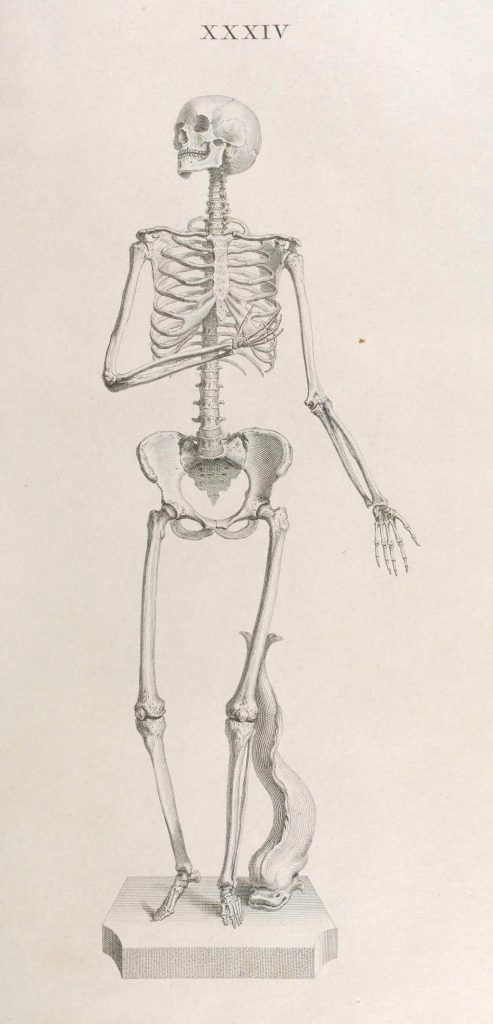
Plate XXXIV. Cheselden, William. Osteographia. 1733. Contributed in BHL from the Library and Archives of the Natural History Museum, London.
Cheselden’s commitment to providing the best available osteological atlas went well beyond a desire to produce an aesthetically-pleasing publication. He wanted the plates in Osteographia to serve as “working objects” for osteological studies — illustrated specimens that could be taken by the scientific community as representative. To accomplish this, accuracy of illustration was paramount (Neher 2010, 519).
To realize this ambition, Cheselden and his artists employed a camera obscura to create the initial drawings. A camera obscura is an instrument consisting of a darkened box with a convex lens or aperture that is used to project the image of an external object onto an internal screen. Cheselden is believed to be the first to use such a device for medical imagery, and the particular camera obscura used was of Cheselden’s own invention (Neher 2010, 522).
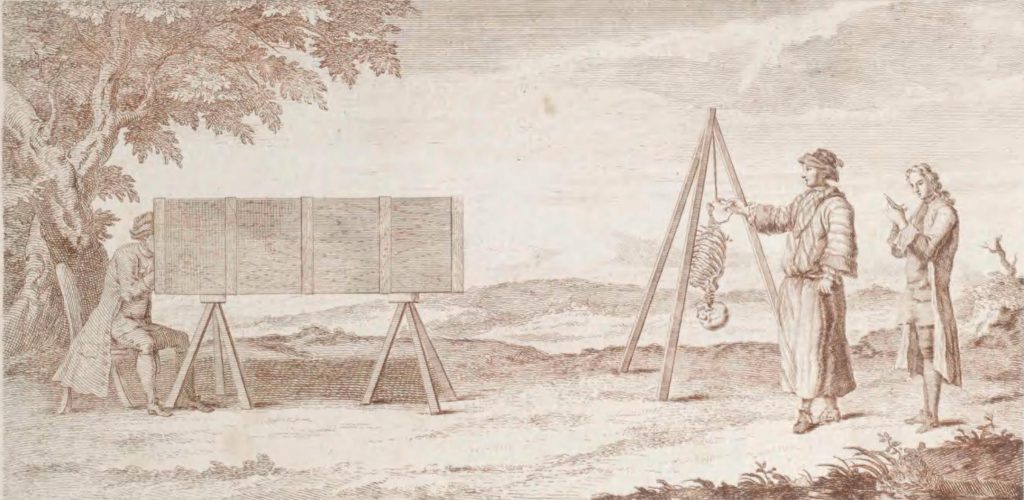
Camera obscura figured in the vignette on the title page. Cheselden, William. Osteographia. 1733. Contributed in BHL from the Library and Archives of the Natural History Museum, London.
The camera obscura is prominently featured in the vignette on the title page of Osteographia. The two standing figures in the vignette are Cheselden’s students, John Belchier and Samuel Sharpe. The identity of the seated figure inside the camera obscura is unknown but may represent one of the artists (Neher 2010, 522).
By displaying the camera obscura so conspicuously on the title page, Cheselden was emphasizing the legitimacy and accuracy of the illustrations within Osteographia. The reader was to understand that the plates were created from actual projections of the skeletons depicted. Cheselden further listed his qualifications on the title page, including his association with the Queen and membership in several prestigious institutions, as further evidence of the credibility of the work (Neher 2010, 519).
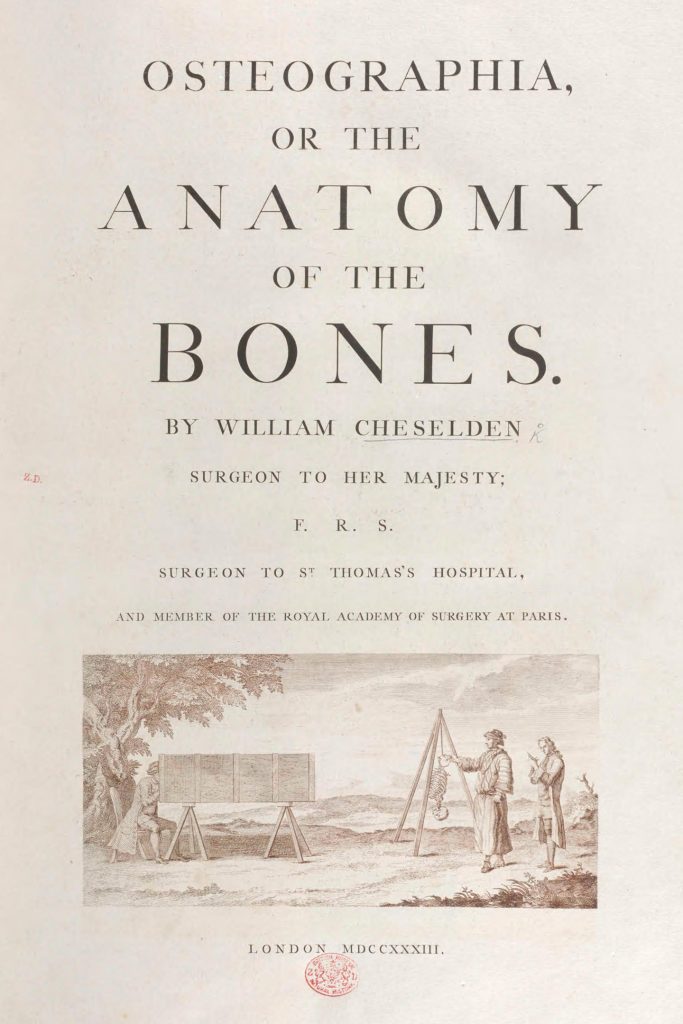
Title page. Cheselden, William. Osteographia. 1733. Contributed in BHL from the Library and Archives of the Natural History Museum, London.
While Cheselden provided direction for the production of each image, intervening when necessary to provide corrections and alterations, the actual artists for Osteographia were Gerard van der Gucht (1695/6-1776) and Jacob Schijnvoet (1685-1733). Based on the drawings created by means of the camera obscura, the final plates were produced through a combination of etching and line engraving. Engraving, in which lines are cut into a metal plate with a burin, was used to produce smooth, dark exterior lines for each bone. Etching, in which an acid wash is used to etch an image drawn into a wax coating on a metal plate, was used for the other parts of the image (Neher 2010, 518).
Many varied issues of Osteographia exist today, as detailed by K.F. Russell in an article within Bulletin of the History of Medicine (vol. 28, no. 1, 1954). While the work was first officially published in 1733, there is a unique, 1728 trial issue in the Hunterian Library at the University of Glasgow which features 56 unlettered plates but no text or letterpress.
In addition to the “typical” 1733 issue, there is also a variant of the 1733 issue in which the title vignette and illustration of a broken column on the final page are printed in red. Additionally, this version presents the engraving of the Royal Arms on the verso of the title page, rather than on a separate page as in the “typical” 1733 issue. Russell postulates that this variant may represent a trial issue printed earlier than the “typical” 1733 issue. The copy of this work available in BHL from the Natural History Museum in London is this 1733 variant issue.
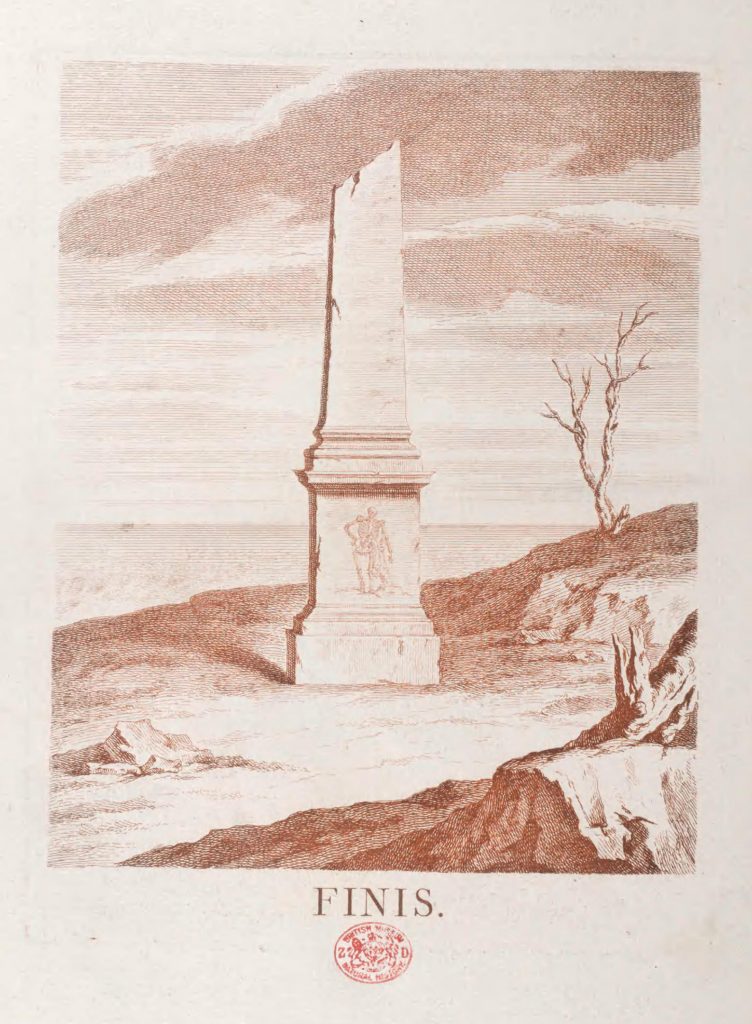
The broken column at the end of this copy is printed in red. This indicates that this copy is a 1733 variant issue. Cheselden, William. Osteographia. 1733. Contributed in BHL from the Library and Archives of the Natural History Museum, London.
Finally, there are several undated versions of the work which likely represent later editions made from sets of the unlettered plates broken up from the original whole and sold as separate, undated volumes in an effort to recoup some of the costs of publication.
Unfortunately, Cheselden did have need to recoup costs from the production of Osteographia. While widely praised, the work was not a commercial success. Of the 300 English copies printed, only 97 were sold by subscription. Of the remaining 203 copies, Cheselden disbound 83 of them, offering sets of the frontispieces and head pieces at 10 shillings each and sets of the 56 plates — which he advertised as “proper ornaments for a surgery” — for 30 shillings each (Russell 1954, 38-44).
Though it may not have been a commercial success, Osteographia was and is still celebrated for its beautiful and accurate illustrations, representing an important contribution to the history of medicine.
So make no bones about it — for those seeking a good skeleton or two this Halloween, Osteographia delivers in spine-tingling spades.
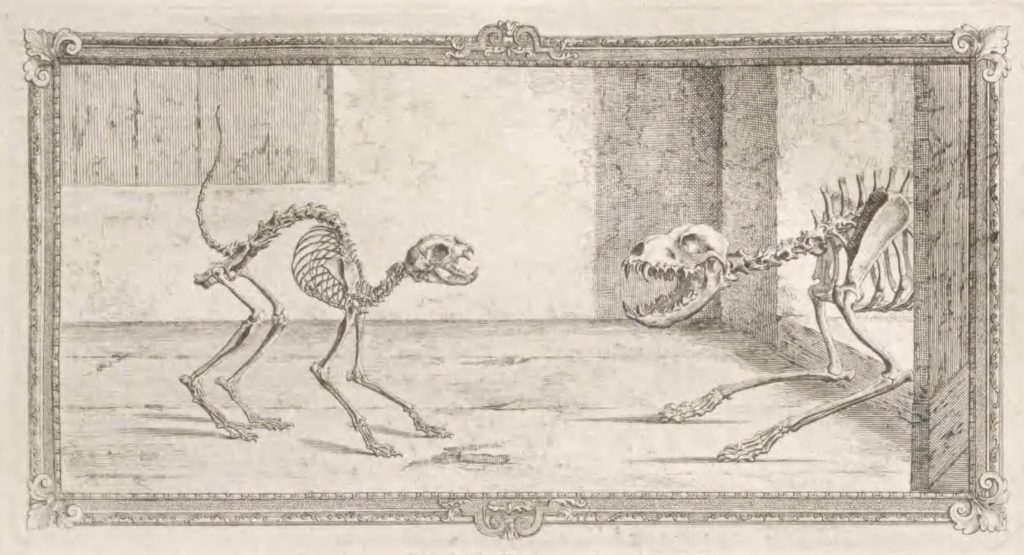
Head-piece engraving for Chapter II. Cheselden, William. Osteographia. 1733. Contributed in BHL from the Library and Archives of the Natural History Museum, London.
References
Cheselden, William. 1733. Osteographia. London: W Boyer.
History.com Editors. 2019. “Halloween 2019.” History.com. September 13. Accessed on October 1, 2019. https://www.history.com/topics/halloween/history-of-halloween.
Neher, Allister. 2010. “The Truth about Our Bones: William Cheselden’s Osteographia.” Medical History 54: 517-528.
Russell, K.F. 1954. “The Osteographia of William Cheselden.” Bulletin of the History of Medicine 28(1): 32-49.
Tikkanen, Amy. 2019. “William Cheselden.” Encyclopedia Britannica. April 6. Accessed on September 30, 2019. https://www.britannica.com/biography/William-Cheselden.





I had a fascinating experience exploring the real human and animal skeletons on this site. The collection is well-curated, educational, and presented with great attention to detail. Whether you’re a student, educator, or simply curious, it’s a captivating resource that combines science with respectful presentation. Highly recommended for anyone interested in anatomy or natural history!